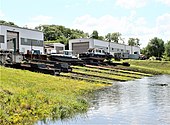Hermann Barthel shipyard
| Shipyard Hermann Barthel GmbH
|
|
|---|---|
| legal form | Company with limited liability |
| founding | 1799 |
| Seat | Derben , Germany |
| management | Hermann Barthel |
| Branch | shipbuilding |
| Website | www.barthelwerft.de |
The shipyard Hermann Barthel GmbH is a shipyard in Derben on the Baggerelbe , an old arm of the Elbe . It deals with the construction, conversion and repairs of ships.
history
Friedrich Lösche founded the shipyard in 1799 with the help of his father. The ships were built of wood at that time and had a size between 50 and 100 tons. Ships up to 500 t were later built here. In 1850 the shipyard was handed over to Friedrich's son Andreas Lösche and in 1899 to Andreas's son Hermann Lösche. Iron ships were built from 1890. When Hermann Lösche died in 1903, his son Hermann took over the shipyard and managed it until 1964. The shipyard was spared from destruction during the two world wars. After that, the son-in-law Günther Barthel took over the shipyard, which was nationalized in 1972 and then run as part of VEB Schiffsreparaturen Berlin . During this time, new ferries were built for the Havel and Saale rivers , and many deliveries were made to the Genthin shipyard , which is now part of SET Schiffbau- u. Development company Tangermünde exists.
After the reunification in 1990, the shipyard was taken over and modernized by Hermann Barthel in the sixth generation. He renewed the slipway and two new shipbuilding halls were built. This means that shipbuilding and repair work can be carried out regardless of the weather.
Building program
The Hermann Barthel shipyard mainly builds and repairs national government ships, customers are the water police , water and shipping authorities and port administrations . This is how police, pilot and work boats came into being. In addition, passenger ships were delivered for Berlin and Hamburg shipping companies and the ocean- going passenger ship Nordwind , which operates around Rügen . Surveying and work ships were delivered for foreign countries.
research
As part of the ELEKTRA research project of the TU Berlin, which deals with the development and optimization of an inland push boat powered by fuel cells and accumulators , a demonstrator, a push boat, is being built at the Hermann Barthel shipyard. The push ship will examine and demonstrate hydrogen and fuel cell technology in interaction with accumulators on inland vessels.
The requirements for the push boat were examined in a preliminary project that ran from April 1, 2017 to September 30, 2019. They resulted from the Behala services, which are to be provided as emission-free as possible in the future. With regard to the thrust, the transport of large Siemens gas turbines in the heavy cargo lighter Ursus (ship) was taken as the basis. This resulted in the maximum thrust load of approx. 1,400 t in both regional and supra-regional operation. The main dimensions resulted from the navigable waterways and locks as well as the cargo to be transported.
It is currently being implemented under the name ELEKTRA-II "Realization and testing of a push ship powered by fuel cells and accumulators" by December 31, 2024, with a total budget of around 13 million euros, half of which is funded.
Project participant
- TU Berlin
- Shipyard Hermann Barthel GmbH
- Imperial Shipping Services GmbH
- SER Schiffselektronik Rostock GmbH
- BEHALA
- ANLEG Gesellschaft mbH
- EST-Floattech BV
Regional use
The regional deployment is planned regionally with 65 km in the Berlin-Brandenburg area and supraregional to the overseas port of Hamburg in the time of four days with around 130 km per day. In regional operation, important industrial locations can be reached with an operating time of 8 hours at a service speed of 8 km / h and at the end of the shift, the Elektra can dock again in the Westhafen .
Nationwide use
In the supraregional operation for gas turbine transport from Berlin to the next overseas port in Hamburg, an average service speed of 8.5 km / h and an operating time of up to 16 hours a day is to be driven. A driver assistance system was developed for energy-saving operation, which also includes route planning and route simulation. A charging and bunker infrastructure must be available on this route for the energy supply. Bunkering with hydrogen and full charging of all batteries must be possible within a period of seven hours. Therefore, in parallel with the construction and testing of the Elektra, accompanying infrastructural measures in the field of electricity and hydrogen supply are being carried out.
Web links
- Shipyard website
- https://hochhaus-schiffsbetrieb.jimdo.com/ursus-und-elektra-innovationen-mit-brennstoffzellen-aus-berlin/ accessed on July 4, 2020: Description of the research project
- https://www.hafen-hamburg.de/de/news/behala-und-partner-fiegen-kiellegung-des-weltweit-ersten-emissionsfrei-schubbootes-elektra---36526 accessed on July 5, 2020
Coordinates: 52 ° 25 ′ 21.4 ″ N , 11 ° 59 ′ 39.6 ″ E





